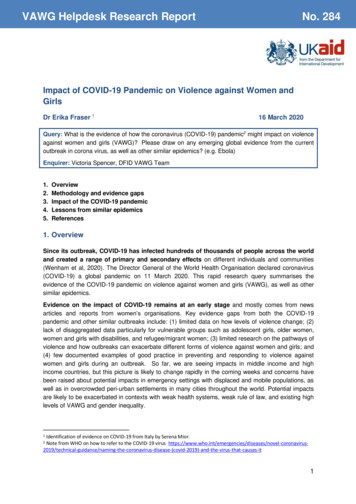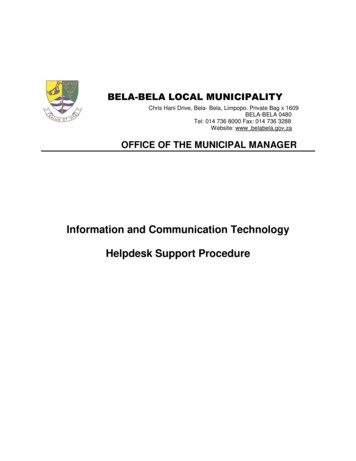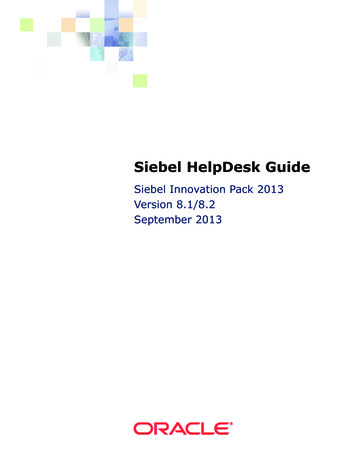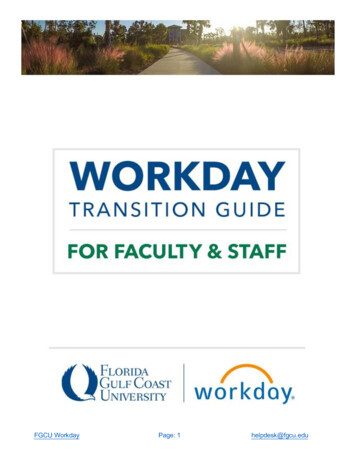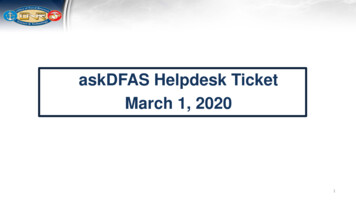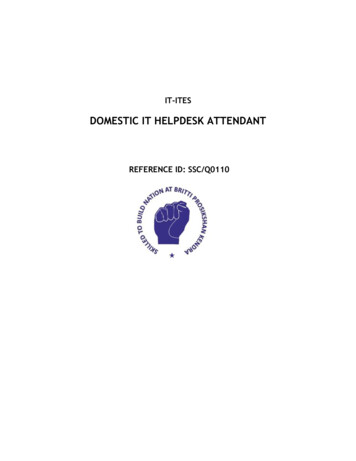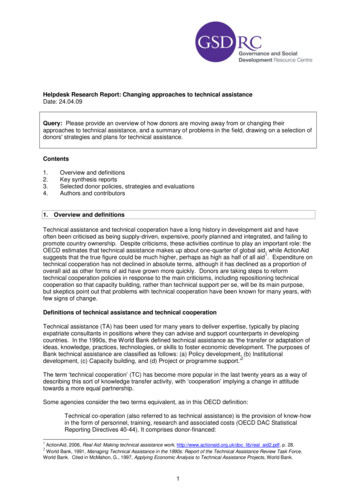
Transcription
Helpdesk Research Report: Changing approaches to technical assistanceDate: 24.04.09Query: Please provide an overview of how donors are moving away from or changing theirapproaches to technical assistance, and a summary of problems in the field, drawing on a selection ofdonors' strategies and plans for technical assistance.Contents1.2.3.4.Overview and definitionsKey synthesis reportsSelected donor policies, strategies and evaluationsAuthors and contributors1. Overview and definitionsTechnical assistance and technical cooperation have a long history in development aid and haveoften been criticised as being supply-driven, expensive, poorly planned and integrated, and failing topromote country ownership. Despite criticisms, these activities continue to play an important role: theOECD estimates that technical assistance makes up about one-quarter of global aid, while ActionAid1suggests that the true figure could be much higher, perhaps as high as half of all aid . Expenditure ontechnical cooperation has not declined in absolute terms, although it has declined as a proportion ofoverall aid as other forms of aid have grown more quickly. Donors are taking steps to reformtechnical cooperation policies in response to the main criticisms, including repositioning technicalcooperation so that capacity building, rather than technical support per se, will be its main purpose,but skeptics point out that problems with technical cooperation have been known for many years, withfew signs of change.Definitions of technical assistance and technical cooperationTechnical assistance (TA) has been used for many years to deliver expertise, typically by placingexpatriate consultants in positions where they can advise and support counterparts in developingcountries. In the 1990s, the World Bank defined technical assistance as 'the transfer or adaptation ofideas, knowledge, practices, technologies, or skills to foster economic development. The purposes ofBank technical assistance are classified as follows: (a) Policy development, (b) Institutional2development, (c) Capacity building, and (d) Project or programme support.'The term „technical cooperation‟ (TC) has become more popular in the last twenty years as a way ofdescribing this sort of knowledge transfer activity, with „cooperation‟ implying a change in attitudetowards a more equal partnership.Some agencies consider the two terms equivalent, as in this OECD definition:Technical co-operation (also referred to as technical assistance) is the provision of know-howin the form of personnel, training, research and associated costs (OECD DAC StatisticalReporting Directives 40-44). It comprises donor-financed:1ActionAid, 2006, Real Aid: Making technical assistance work, http://www.actionaid.org.uk/doc lib/real aid2.pdf, p. 28.World Bank, 1991, Managing Technical Assistance in the 1990s: Report of the Technical Assistance Review Task Force,World Bank. Cited in McMahon, G., 1997, Applying Economic Analysis to Technical Assistance Projects, World Bank.21
Activities that augment the level of knowledge, skills, technical knowhow or productiveaptitudes of people in developing countries; andServices such as consultancies, technical support or the provision of know-how that3contribute to the execution of a capital project.More often, though, 'technical cooperation' is the more common term for describing overall strategyand as a broad description of „any activity aimed at enhancing human and institutional capabilities4through the transfer, adaptation and utilisation of knowledge, skills and technology‟ while 'technicalassistance' is used more narrowly to describe specific operational aspects of technical cooperation,as in this definition from the European Commission:Technical Cooperation is often associated with actions aimed at strengthening individual andorganisational capacity by providing expertise (short and long term TA personnel, institutionaltwinning arrangements, mobilisation of diaspora, etc.), training and related learning opportunities (peer exchange, tertiary education, etc.), and equipment. Technical Assistance (TA) refers to the personnel involved in the implementation and the management of technical coop5eration services.Criticisms of technical assistance/cooperationTechnical assistance and technical cooperation have often been criticised. The most commongrounds for criticism include: Supply-driven: Activities tend to be driven by donors rather than provided in response todeveloping countries‟ priorities.Country ownership: There is often a low level of ownership and involvement on the part ofpartner countries. This may in some cases be due to insufficient country-level capacity,political will, leadership or initiative, but can also be due to donor controls and the use ofparallel management structures (see PIUs, below). Technical assistance personnel are oftenmore accountable to donors than to the countries they are working in.Parallel implementation units (PIUs): The use of management systems created outside thenational civil service has been common, but they tend to undermine national capacitydevelopment, distort public-sector salaries and diffuse accountability.Planning and design of interventions: Weak procedures for identifying needs and for planningand designing technical cooperation support, including lack of clarity about roles and resultsexpected.Contextual analysis: Insufficient analysis of national contexts and underlying capacityconstraints.Cost: Technical cooperation is seen as relatively expensive, and this has been exacerbatedby tied aid. It is often said that reliance on Western providers results in high costs, but somestudies have noted that local providers are not always significantly cheaper, particularly inAfrica.Selection of personnel: Insufficient attention is given to ensuring that TA personnel have thenecessary skills and profiles (including interpersonal skills and the ability to transferknowledge as well as technical skills) to be able to engage effectively in demanding changeprocesses.Weak integration and coordination: Technical cooperation initiatives are often not wellintegrated with national development strategies, or are poorly coordinated with other activitiestaking place in countries.Lack of consideration of alternatives: In many cases, the provision of TA personnel and theuse of parallel implementation units is taken as a given, without questioning theirappropriateness, and there is limited experience in the use of alternative forms of provision3OECD, 2008, 2008 Survey on Monitoring the Paris Declaration, Organisation for Economic Co-operation and 02121.pdf, p. 1494ECDPM, 1995, New Avenues for Technical Cooperation in Africa: Improving the record in terms of capacity building, PolicyManagement Report No. 2, European Centre for Development Policy Management5European Commission, 2008, Reforming Technical Cooperation and Project Implementation Units for External Aid providedby the European Commission: A Backbone Strategy, EuropeAid, Directorate E, European Commission.2
such as the use of public sector expertise through twinning arrangements and South-Southcooperation.Current trends in technical cooperationDonors are changing their approaches to technical cooperation in response to criticisms, but changehas been slow. Trends have been observed in the following areas: Increasing country ownership: Donors agree that local ownership of technical cooperation isimportant and are implementing policies designed to encourage greater local participation inplanning and design of interventions, as well as in management, evaluation, andaccountability. As part of this, donors have committed to reducing the number of parallelimplementation units and drawing more on national management systems. There is slow butsignificant progress towards these goals.Increasing use of national consultants: There is a strong desire among donors to use morelocal consultants rather than international ones, and to encourage South-South cooperation.Procurement systems are being reformed with these goals in mind.Expenditure constant or increasing: The volume of technical cooperation, which constitutesbetween a quarter and a half of all ODA, is either increasing or remaining constant in manycountries, but it is declining as a proportion of ODA as other forms of aid such as general andsector budget support have been growing quickly.Improving coordination and integration: Technical cooperation is becoming better coordinatedand aligned with national programmes, although a large proportion of activities are still notwell linked to other strategies.Pooling technical assistance funds: There has been a trend towards arrangements wheredonors pool their funds for technical assistance to improve coordination and encouragecountry leadership.Shorter interventions: There is a trend away from long-term technical assistance to short-termtechnical advice that avoids substitution.Purpose shifting towards capacity building: Many agencies now see technical cooperation asbeing primarily and explicitly for the purpose of capacity building, and are designing initiativesaccordingly, rather than solely focusing on technical support.Untying aid: On the whole, donors have continued the trend towards untying aid, althoughsome lag behind.2. Key synthesis reportsOECD/DAC, 2009, ‘Inventory of Donor Approaches to Capacity Development: What We AreLearning’, Organisation for Economic Co-operation and m/files/c4d/21 INVENTORY OF DONORS Final.pdfThis study provides information about current capacity development activities of DAC membercountries, including technical cooperation and technical assistance. The authors note that technicalcooperation is the most common form of capacity building activity and that it „includes the provision oftechnical assistance to partner countries through technical and advisory services provided byexpatriate experts. Donors such as France, Australia and Japan have a tradition of appointing expertsto work as advisors within partner country systems, often in long-term positions. However, the overallcurrent trend is increasingly to move from long-term technical assistance to short-term, focusedtechnical advisory services that avoid substitution, and to increase the use of local technicalexpertise.‟ (p. 6)According to the study, donors „seek to integrate technical cooperation into a broader framework ofcapacity development vision and support, often affiliated with the political will for change. Donorsacknowledge that, ideally, technical cooperation should be country-led, country-owned, countrymanaged, and fully integrated in the context of national sector programmes. Many strongly advocateSouth-South co-operation approaches and the use of local capacities. Yet, they also point out thattechnical cooperation at the field level often remains far from these goals. Interventions may remainfocused on task specific, traditional training and skill building, sometimes qualified as “substituting”rather than enhancing local capacity . Various initiatives, including evaluation exercises, mapping3
studies and revision of guidelines, are currently taking place or have been recently launched to reformtechnical co-operation.‟ (p. 8)The study summarises capacity building, technical cooperation and technical assistance activities of20 countries and five multilateral donors. A few highlights are included below: France: „France‟s technical assistance presence in the field has been very significant. In thelast two decades, France has made great efforts to move from massive French “substitution”technical assistance (23,000 persons in 1980) to short term, focused international technicalexpertise (1,200 experts in the field in 2008). France‟s new approach to technical assistanceaims at building up and supporting local expertise. France intends to improve the integrationof its technical assistance into joint approaches to capacity building that will encourageownership and reduce the risks of substitution, to align its activities with national systems, andto make use of local capacities to carry out the country‟s programme . France is currently inthe process of reviewing and modernizing its approach to technical assistance. This processwill include the promotion of South-South cooperation and the provision of technicalassistance to organizations outside government structures.‟ (p.25)Ireland: „Irish Aid uses technical assistance within the context of sector or programmesupport, and tries to fully embed it in the context of local structure and management systems.Many Country Strategy Plans include a process fund which can be drawn on to supportdemand-led technical assistance or short term consultancy inputs that support capacitydevelopment . Irish Aid promotes local knowledge and experience and the use of localconsultants and local institutions to the maximum extent possible.‟ (p. 30-31)Netherlands: „In 2002, the former Dutch Minister for Development Cooperation decided todiscontinue the provision of technical assistance, which she saw as too supply-driven. TheNetherlands strongly supports the shift towards demand-driven development co-operationpractices and is currently in the process of rethinking its technical cooperation approachesand modalities.‟ (p. 35)Norway: „As with other donors, technical assistance remains a major capacity developmentexpenditure item each embassy with a development co-operation budget has a localconsultancy fund for hiring local expertise and building capacity among local trainedprofessionals, rather than bringing in consultants from Norway. the Norwegian DevelopmentAssistance Strategy for 2008 explicitly mentions the goal to increase capacities at institutionsin the South, and stimulate South-South-North cooperation in the education sector.‟ (p. 37)Spain: „Spanish technical assistance remains in demand, as it fits into local processes andpriorities. Demand for this is particularly strong in Latin America because of historical andcultural ties and affinities, as well as similarities in administrative and legal systems. Anadditional driver for the use of Spanish expertise in development co-operation programmescould be to maintain support for development co-operation within the Spanish public. Spainincreasingly seeks to provide technical assistance using locally or regionally availableexpertise, thereby strengthening South-South co-operation. The Peer Review recognizesSpain‟s good experience with technical assistance, and suggests the utility of analysing“where, why and how” that its support to capacity development has been effective and whatlessons could be replicated elsewhere.‟ (p. 38)Sweden: „SIDA has been using technical cooperation to support capacity development,mostly in the forms of education and training, twinning, and technical assistance delivered byinternational experts . The 2005 Manual recognises that SIDA capacity developmentinterventions have primarily focussed on the “lower” target levels, i.e. the individual andorganizational levels, with little concrete experience on influencing systems of organizationsand institutional frameworks. In relations to support to public sector reform and majorprogramme based approaches, the memorandum explain that local capacity (consultants,training institutions, think tanks, universities, etc.) are often recruited to provide technicalassistance as part of the capacity development or reform programmes.‟ (p. 40)JICA, 2008, ‘Effective Technical Cooperation for Capacity Development’, Japan InternationalCooperation Agency. http://www.jica.go.jp/cdstudyThis joint study involving eleven countries and seven development agencies argues that technicalcooperation is an important part of aid strategy, particularly for capacity development, and that4
„understanding of the importance of technical cooperation, interest in ensuring its effectiveness andknowledge of good practice is growing‟ (Key Findings, p. 3).The study finds that technical cooperation (TC) is more likely to be effective when the followingfeatures are in place (Synthesis Report, p. 72): Country-led planningFlexible and responsive designEmbedding within an organizational change processCountry-led managementComplementarity with other forms of supportEmbedding within an organizational learning process.Countries are making good progress towards improving technical cooperation effectiveness at thenational and sector levels. At the national level, country ownership and leadership are strengtheningand interest in TC and capacity development (CD) issues moving up the policy agenda, but the studyrecommends that more should be done to nurture and promote country ownership. At the sectorlevel, policies and strategies are linked to country-led sector wide or program based approaches, andjoint sector working groups are operational, but CD and TC strategies and priorities need to be betterarticulated and country capacity to formulate capacity improvement strategies needs to bestrengthened.Detailed case studies of Cambodia, Ghana, Kenya, Laos, Malawi, Malaysia, Pakistan, Tanzania,Thailand, Vietnam, and Zambia, are available at http://www.jica.go.jp/cdstudy.Land, T., 2007, ‘Joint Evaluation Study of Provision of Technical Assistance Personnel: Whatcan we learn from promising experiences? Synthesis Report’, European Centre forDevelopment Policy Management, Discussion Paper 78. http://www.ecdpm.org/dp78This study focuses on the provision of technical assistance personnel, drawing on country studiesconducted in Mozambique, Solomon Islands and Vietnam. The study‟s key conclusions are: Development agencies need to let go of technical assistance management in order toempower country partners.Country management of TA personnel is a key determinant of effectiveness. Thisincludes decisions about recruitment and deployment, and once deployed, TA personnelshould be unambiguously accountable to the host organisations they serve. Somecountries may lack sufficient management capacity, in which case progressive or interimsupport measures may be needed.A more informed understanding of how TA can support capacity development andchange is the other key determinant of effectiveness. Having an explicit theory of actionwith an understanding of how different models of change can contribute to capacitydevelopment should increase the chances of success.Good design is important, including proper diagnosis of need, a flexible mix ofapproaches including iterative approaches, and monitoring and evaluation systems thataddress accountability and learning and provide the right incentives.Country partners need to come to grips with human resources planning and managementand think strategically about the use of TA personnel. TA provision can never be asubstitute for reforming the public service.Three country case studies were developed as part of this work: Mozambique: http://www.ecdpm.org/dp75Solomon Islands: http://www.ecdpm.org/dp76Vietnam: http://www.ecdpm.org/dp775
Williams, G., Jones, S., Imber, V., and Cox, A., 2003, ‘A Vision for the Future of TechnicalAssistance in the International Development System’, Oxford Policy Management.http://www.opml.co.uk/policy areas/aid policy/ed768 vision ta.htmlThis influential study commissioned by DFID „presents a vision for the future of Technical Assistancethat is based around moving from regarding Technical Assistance as an instrument of donor policy,towards a focus on building capacity for developing country governments to procure and manageadvisory services.‟ (p. iii) The authors call for aid to be untied and delivered through partner countrygovernment budgets, and for procurement of skills and services to be done through nationalprocurement systems, with strengthening of such systems where necessary. Where countries lacksufficient local capacity to procure and manage technical assistance, they argue that this capacityneeds to be supported and developed. „The main examples of reform in TA provision including theremoval of tying, the use of pooled arrangements and routing through national budget or procurementsystems are found among the smaller providers there has been slow progress in changing technicalassistance practices but there are positive examples of change‟ (p. iv).ActionAid, 2006, Real Aid: Making technical assistance work.http://www.actionaid.org.uk/doc lib/real aid2.pdfActionAid calculates that at least one-quarter of donor spending, and perhaps as much as half of allODA, is in the form of technical assistance, and argues that it is overpriced and under-evaluated.„Like a relic from an earlier age, technical assistance has been largely insulated from donors‟ efforts toimprove the quality of their aid and to act on the widely advertised principles of ownership andpartnership. Too much of it continues to be identified, designed and managed by donors themselves,tied to donor countries‟ own firms, poorly co-ordinated and based on a set of often untestedassumptions about expatriate expertise and recipient ignorance.‟ (p. 3) Specifically, ActionAid arguesthat (p. 29-41): Technical advisers are often under pressure from donors and governments to „get the jobdone‟ rather than take extra time to build capacityAdvisers often have incentives not to pass on knowledge to their counterpartsTechnical advisers are more focused on meeting donor demands than building capacityAdvisers have often lacked skills or expertise in building capacitySome governments have not been strategic in their use of technical assistanceHeavy use of expatriate consultants can foster a „dependency culture‟The common failure of donor co-ordination has fuelled the problemCapacity building initiatives have been undermined by a lack of policy coherence.Costs and prices play a limited role in determining demand and supply, leading to high costsMuch technical assistance is officially tied, and donors prioritise their own nationals evenwhen technical assistance is not officially tiedHeavy use of expatriate advisers inflates costs because of associated expensesThe technical assistance market is highly inflexible and competition is severely limitedDonors want to maintain control and meet disbursement timetablesTechnical assistance is used to ensure that aid money is well spentDonors use technical assistance alongside conditionality to promote reforms they consider tobe importantTechnical assistance contributes to donor geopolitical or commercial objectivesThere is a lack of clear strategic framework for capacity buildingTechnical assistance is seen as a „free good‟Too much emphasis is placed on technical solutions to what are often social and politicalproblemsToo much value is placed on international expertise and experts, and not enough on localknowledge, and experts with understanding of the local political, social and cultural contextIt is often incorrectly assumed that learning is always one way; from expert to recipientThe study recognises efforts at reform including the Paris Declaration (although describing thedeclaration as being particularly weak on technical assistance) and is optimistic about the increasinglycommon practice of pooling funds and the shift towards „greater use of country systems, whichappears to be generating some benefits in terms of enhancing government ownership‟ (p. 42).6
ActionAid makes the following recommendations for improving technical assistance (p. 49): Draw up capacity building plans based on national development strategiesEnsure technical assistance contributes to capacity buildingEnsure transparency and accountability in the use of resourcesEnsure that women‟s rights are fully taken into accountAllow southern countries to take the lead in the capacity building processMake maximum use of country systems, including for procurement, financial managementand reportingDo not use technical assistance to either substitute for or complement conditionalityBe fully transparent, to both citizens and poor countries, about funding for technicalassistance and its impactEnsure greater cost effectiveness, by ensuring that all technical assistance contracts are fullycompetitive and that bids are made fully transparentStrengthen the targets agreed under the Paris DeclarationCollect and make available more data on donor-by-donor spendingMorgan, P., 2001, ‘Technical Cooperation – Success and Failure: An Overview’, United NationsDevelopment n%20TC%20Success%20and%20failure.pdfThis paper examines factors contributing to the success or failure of technical assistance in differentcircumstances and suggests possible improvements to TA practice. It notes the following „corrosivepractices‟: Erosion of ownership, commitment and independent action of national actorsUndermining the functional capabilities of those whom TA was trying to assistEncouraging countries to put in place the wrong policies, organizations and institutionsLack of sustainable impactSelf-perpetuation and excessive costsDamaging the motivation and sense of professionalism of some donor staffOn the other hand, technical assistance has been successful when the following circumstances arepresent: Interventions are designed around capacity building and the contribution of TA to thatprocess. A good fit (in terms of context, purpose, strategy, methodology and management) betweenTA and other organisational factors. A pre-existing sense of country ownership and control: „TA could damage country ownershipbut could not do much to create it‟ (p. 14). A „learning organisation‟ capacity to sort, synthesize, discard and customise technicalknowledge, sifting through the flow of TA advice and picking out what is relevant to problemsand conditions at hand. Appropriate organisational and personal relationships, where power and authority isdelegated to the project level and managed according to the needs of the participants, whereTA providers assumed an important but secondary role, and donors focused on support,facilitation, learning and buffering. A network of champions who are committed to the intervention including entrepreneurs,protectors, managers, and followers. An effective approach to change management, including careful attention to timing andsequencing. Quick initial benefits can be realised to establish credibility and momentum, alongside moreprofound reform over the long term.The author argues that TA is changing so as to encourage country ownership of developmentinterventions, reduce fragmentation, and encourage more trust and collective action amongst all theparticipants.7
ECDPM, 2002, ‘Pooling of Technical Assistance’, Capacity.org, European Centre forDevelopment Policy Management, Maastricht.http://www.capacity.org/Web Capacity/Web/UK A3E7C/ FILE/issue-12e.pdfThis paper summarises a six-country study on „the pooling of funds to finance technical assistance(TA) in the context of sector-wide approaches (SWAps) and other new aid mechanisms.‟ (p. 2)Pooling funds „has been proposed as a means to reduce the fragmentation of development activitiesand to encourage country leadership.‟ (p. 2) This study argues that „pooling of TA is still in its infancy,although there are some modest but promising signs in several of the countries examined. The moveto pooling is part of a broader change in the design and management of international developmentcooperation, at the core of which is the emphasis on country ownership and control.‟ (p. 5) Inparticular, the study reports that: Current levels of pooling are low but increasingThe ability to pool funds has been restricted by national capacity shortagesPooling has not yet demonstrated an increase in country ownershipSmall, incremental, and context-sensitive initiatives stand a better chance of success thancomprehensive onesPooling has not affected the quantity or cost of technical assistanceMany agencies are still reluctant to untie aidLocal technical assistance, especially in Africa, is increasingly expensive and is often nocheaper than foreign assistanceEfficiency gains due to pooling have been mixed: most initiatives have proven more complexthan predicted, but there are emerging signs of improving efficiencyPooling tends to highlight the comparative advantages and costs of different providers, andthus increase transparency.Hauck, V., and Baser, H., 2005, ‘TA Pooling: Tools and Lessons Learned’, DFID HealthResource Centre, alth service delivery/TA Pooling Dec05.pdfThis report describes technical assistance pooling arrangements and trends in Africa, Asia and LatinAmerica. Technical assistance pooling can be described in terms of three levels (full, mixed, andloose) and four models (delegated cooperation, integrated TA, TA in isolated units, and regional TAsupport facilities). The study finds that: Funding for TA is primarily organised by sectors or themes Many arrangements aim to be „full‟ pooling but are in practice „loose‟ and could remain so fora considerable time given weak national management capacities The type of pooling selected must be appropriate to the circumstances Applying a mix of mechanisms to a situation can be a useful strategy Pooling depends on a critical mass of like-mindedness among partner countries anddevelopment agencies Building mutual trust based on a shared understanding is the foundation of most successfulTA pooling exercises (including trust among development agencies, not just betweenagencies and countries).The study argues, „pooling for TA or other purposes is not a panacea. It has significant costs in termsof time and resources. It may divert resources from more substantive activity. There is also the riskthat the difficulties inherent in
Helpdesk Research Report: Changing approaches to technical assistance Date: 24.04.09 Query: Please provide an overview of how donors are moving away from or changing their approaches to technical assistance, and a summary of problems in the field, drawing on a selection of donors' s
